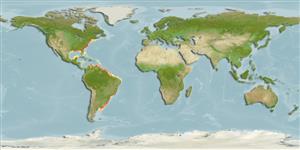Lớp phụ Cá sụn (cá mập và cá đuối) (sharks and rays) >
Myliobatiformes (Stingrays) >
Myliobatidae (Eagle and manta rays)
Etymology: Myliobatis: Greek, mylo = mill + Greek, + Greek, batis,-idos = a ray (Raja sp.) (Ref. 45335).
Eponymy: Christophe/Chrétien-Paulin de la Poix Chevalier de Fréminville (1787–1848) was a French naval officer and naturalist. [...] (Ref. 128868), visit book page.
More on author: Lesueur.
Environment: milieu / climate zone / depth range / distribution range
Sinh thái học
Biển; Thuộc về nước lợ Sống nổi và đáy; Mức độ sâu 0 - 100 m (Ref. 57911), usually 1 - 10 m. Subtropical; 43°N - 42°S, 97°W - 33°W
Western Atlantic: continental waters from Cape Cod to southeastern Florida (?) in the USA; also southern Brazil to Argentina (Ref. 58839). Reported (but not known for certain) from Gulf of Mexico, Florida and Caribbean islands, and northern South America. Often confused with Myliobatis goodei (Ref. 3173).
Length at first maturity / Bộ gần gũi / Khối lượng (Trọng lượng) / Age
Maturity: Lm 65.0, range 60 - 70 cm
Max length : 129 cm WD con đực/không giới tính; (Ref. 49746); common length : 70.0 cm WD con đực/không giới tính; (Ref. 5217)
Disk broad with long sharply pointed wings and projecting snout. Tail very long, Few middorsal spines on disk in adults (Ref. 7251). Greyish, reddish chocolate or dusky brown above. Lower surface either pure white or whitish. Teeth green (Ref. 6902).
Found frequently in coastal waters to 10 m depth, mainly in shallow estuaries. Capable of traveling long distances, occasionally leaps out of the water. Swims in midwater. Cruises slowly over the bottom, rooting out bivalves with its beak and wings when feeding (Ref. 7251). Ovoviviparous (Ref. 50449).
Exhibit ovoviparity (aplacental viviparity), with embryos feeding initially on yolk, then receiving additional nourishment from the mother by indirect absorption of uterine fluid enriched with mucus, fat or protein through specialised structures (Ref. 50449).
Robins, C.R. and G.C. Ray, 1986. A field guide to Atlantic coast fishes of North America. Houghton Mifflin Company, Boston, U.S.A. 354 p. (Ref. 7251)
IUCN Red List Status (Ref. 130435: Version 2024-2)
Threat to humans
Harmless
Human uses
Các nghề cá: buôn bán nhỏ
Các công cụ
Special reports
Download XML
Các nguồn internet
Estimates based on models
Preferred temperature (Ref.
123201): 14.2 - 28.1, mean 24.2 °C (based on 594 cells).
Phylogenetic diversity index (Ref.
82804): PD
50 = 0.5002 [Uniqueness, from 0.5 = low to 2.0 = high].
Bayesian length-weight: a=0.00389 (0.00119 - 0.01269), b=3.08 (2.83 - 3.33), in cm total length, based on LWR estimates for this (Sub)family-body shape (Ref.
93245).
Mức dinh dưỡng (Ref.
69278): 3.4 ±0.0 se; based on diet studies.
Thích nghi nhanh (Ref.
120179): Rất thấp, thời gian nhân đôi của chủng quần tối thiểu là hơn 14 năm (Fec=4-8).
Fishing Vulnerability (Ref.
59153): Very high vulnerability (83 of 100).
Nutrients (Ref.
124155): Calcium = 17.7 [3.0, 78.8] mg/100g; Iron = 0.619 [0.159, 1.673] mg/100g; Protein = 21.5 [16.5, 26.6] %; Omega3 = 0.259 [0.074, 0.765] g/100g; Selenium = 23.1 [6.7, 60.5] μg/100g; VitaminA = 10.5 [4.4, 24.4] μg/100g; Zinc = 0.737 [0.363, 1.334] mg/100g (wet weight);
